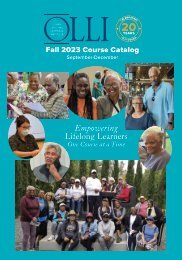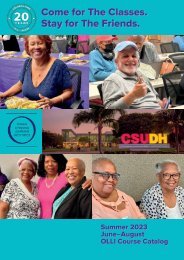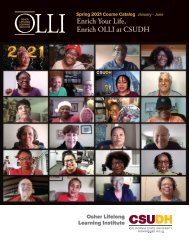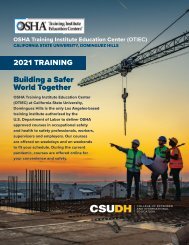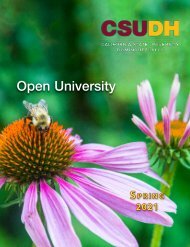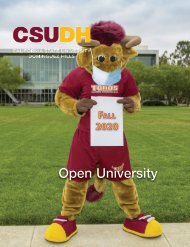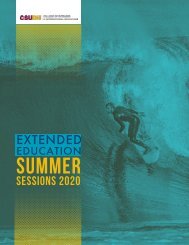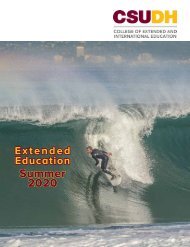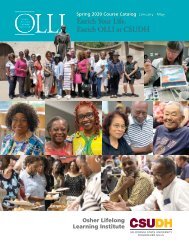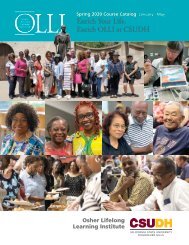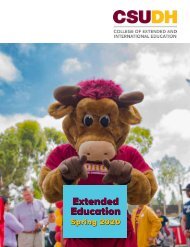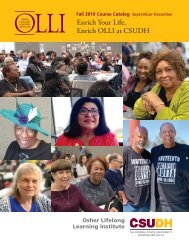Fall 2016 OLLI Catalog
The Osher Lifelong Learning at California State University Dominguez Hills is a program of educational, cultural, and social opportunities for retired and semi-retired individuals age 50 and above. Members experience taking courses in a relaxed atmosphere for the pure pleasure of learning.
The Osher Lifelong Learning at California State University Dominguez Hills is a program of educational, cultural, and social opportunities for retired and semi-retired individuals age 50 and above. Members experience taking courses in a relaxed atmosphere for the pure pleasure of learning.
Create successful ePaper yourself
Turn your PDF publications into a flip-book with our unique Google optimized e-Paper software.
PEER-LED CLASSES (Omnilore)<br />
(RUS) Unresolved Conflicts<br />
In The Former USSR<br />
Since the collapse of the Soviet Union, conflict in the former USSR<br />
has been a key concern for international security. This S/DG will<br />
study the violent conflicts within a region that contains all the<br />
modern ingredients for instability and aggression. It will examine<br />
current debates in international relations about power, interests,<br />
globalization, and the politics of identity as major drivers of contemporary<br />
war. Incidents such as the 2008 Russo-Georgian conflict,<br />
the wars in Chechnya, and Russia’s struggles over national identity<br />
and resources with the Ukraine and Moldova over the Crimea and<br />
the Trans-Dniester will provide ample material for presentations<br />
and discussions. With new issues like energy security, terrorism and<br />
transnational crime, and older tensions between East and West<br />
threatening to deepen once more, this is an important subject for<br />
addressing international security.<br />
Common Reading:<br />
Putin’s Wars: The Rise of<br />
Russia’s New Imperialism<br />
by Marcel H. Van Herpen<br />
(February 2014)<br />
(SAR) The Quartet: Orchestrating<br />
The Second American Revolution, 1783-1789<br />
The success of the American Revolution in 1781 secured the<br />
independence of the thirteen American colonies. The Articles of<br />
Confederation adopted shortly thereafter was not the creation of<br />
a nation so much as it was a mutual security pact between the<br />
thirteen newly sovereign entities. In our common reading, Joseph<br />
Ellis explores how a small group of prominent leaders were able to<br />
lead the transformation from a loose confederation of states to a<br />
nation-size republic. Ellis focuses on four of these transformational<br />
leaders: George Washington, Alexander Hamilton, John Jay, and<br />
James Madison. Along with several others (Robert Morris, Gouverneur<br />
Morris, and Thomas Jefferson) they managed to diagnose the<br />
dysfunctions of the existing system, force a calling of the Constitutional<br />
Convention, set the agenda in Philadelphia, orchestrate the<br />
debates in the various ratifying states, and draft the Bill of Rights to<br />
ensure state compliance with the constitutional settlement. Join us<br />
as we review the achievements of these men and this period, which<br />
Ellis argues is perhaps the most creative and consequential act of<br />
Common Reading:<br />
The Quartet: Orchestrating<br />
the Second American Revolution<br />
1783-1789<br />
by Joseph Ellis (May 2015)<br />
<strong>Fall</strong> <strong>2016</strong> | www.csudh.edu/olli | 310-243-3208 41




